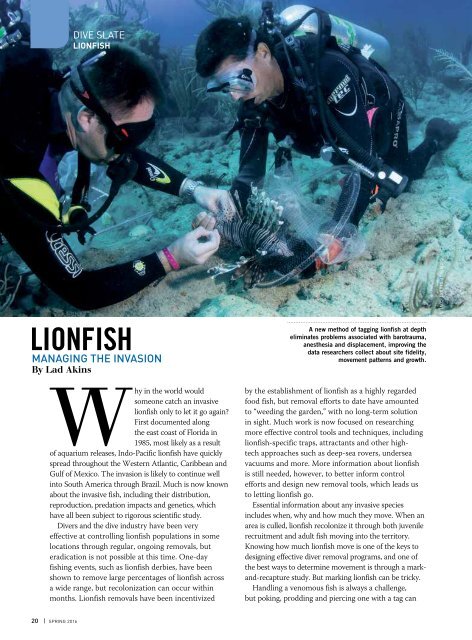AD 2016 Q2
As we pointed out in the spring 2013 edition of the Alert Diver, even being a dive buddy has potential legal implications. So, to bump this up a notch, what about the diver training organisations themselves? Where do they stand? How do they relate to South African law? Are they all considered the same under our legal system in spite of the differences in organisational structures and training programmes? How does this affect their respective instructors and trainee divers from a legal perspective? These are not exactly simple questions. It is certainly true that the respective training organisations differ in a number of ways. However, this does not imply that there are necessarily differential legal implications for each of them. In fact, under South African law, the legal principles are common in all matters. Therefore, if you suffer a loss and you (or your estate in the case of a fatality) wish to recover damages, the legal principles would be applied commonly; whether you are driving or diving. Although not a frequent occurrence, there have been quite a number of law suits associated with diving injuries and damages in South Africa. This is not surprising, as the occurrence of law suits is really a function of “numbers”. As training increases, so do the chances of injuries and, with it, the chances of legal recourse. So, it remains wise to insure yourself, your equipment or your business in a proper and effective way. But before getting back to the potential differences amongst the training agencies, let’s first explore the foundational legal principles on which any civil claim would be adjudicated: inherent risk, negligence and duty to take care.
As we pointed out in the spring 2013 edition of the Alert Diver, even being a dive buddy has potential legal implications. So, to bump this up a notch, what about the diver training organisations themselves? Where do they stand? How do they relate to South African law? Are they all considered the same under our legal system in spite of the differences in organisational structures and training programmes? How does this affect their respective instructors and trainee divers from a legal perspective? These are not exactly simple questions.
It is certainly true that the respective training organisations differ in a number of ways. However, this does not imply that there are necessarily differential legal implications for each of them. In fact, under South African law, the legal principles are common in all matters. Therefore, if you suffer a loss and you (or your estate in the case of a fatality) wish to recover damages, the legal principles would be applied commonly; whether you are driving or diving.
Although not a frequent occurrence, there have been quite a number of law suits associated with diving injuries and damages in South Africa. This is not surprising, as the occurrence of law suits is really a function of “numbers”. As training increases, so do the chances of injuries and, with it, the chances of legal recourse.
So, it remains wise to insure yourself, your equipment or your business in a proper and effective way. But before getting back to the potential differences amongst the training agencies, let’s first explore the foundational legal principles on which any civil claim would be adjudicated: inherent risk, negligence and duty to take care.
Create successful ePaper yourself
Turn your PDF publications into a flip-book with our unique Google optimized e-Paper software.
DIVE SLATE<br />
LIONFISH<br />
COURTESY STUART COVE’S<br />
LIONFISH<br />
MANAGING THE INVASION<br />
By Lad Akins<br />
Why in the world would<br />
someone catch an invasive<br />
lionfish only to let it go again?<br />
First documented along<br />
the east coast of Florida in<br />
1985, most likely as a result<br />
of aquarium releases, Indo-Pacific lionfish have quickly<br />
spread throughout the Western Atlantic, Caribbean and<br />
Gulf of Mexico. The invasion is likely to continue well<br />
into South America through Brazil. Much is now known<br />
about the invasive fish, including their distribution,<br />
reproduction, predation impacts and genetics, which<br />
have all been subject to rigorous scientific study.<br />
Divers and the dive industry have been very<br />
effective at controlling lionfish populations in some<br />
locations through regular, ongoing removals, but<br />
eradication is not possible at this time. One-day<br />
fishing events, such as lionfish derbies, have been<br />
shown to remove large percentages of lionfish across<br />
a wide range, but recolonization can occur within<br />
months. Lionfish removals have been incentivized<br />
A new method of tagging lionfish at depth<br />
eliminates problems associated with barotrauma,<br />
anesthesia and displacement, improving the<br />
data researchers collect about site fidelity,<br />
movement patterns and growth.<br />
by the establishment of lionfish as a highly regarded<br />
food fish, but removal efforts to date have amounted<br />
to “weeding the garden,” with no long-term solution<br />
in sight. Much work is now focused on researching<br />
more effective control tools and techniques, including<br />
lionfish-specific traps, attractants and other hightech<br />
approaches such as deep-sea rovers, undersea<br />
vacuums and more. More information about lionfish<br />
is still needed, however, to better inform control<br />
efforts and design new removal tools, which leads us<br />
to letting lionfish go.<br />
Essential information about any invasive species<br />
includes when, why and how much they move. When an<br />
area is culled, lionfish recolonize it through both juvenile<br />
recruitment and adult fish moving into the territory.<br />
Knowing how much lionfish move is one of the keys to<br />
designing effective diver removal programs, and one of<br />
the best ways to determine movement is through a markand-recapture<br />
study. But marking lionfish can be tricky.<br />
Handling a venomous fish is always a challenge,<br />
but poking, prodding and piercing one with a tag can<br />
20 | SPRING <strong>2016</strong>









